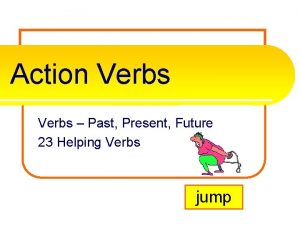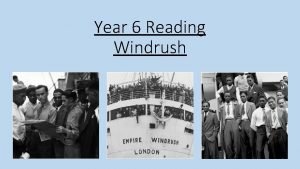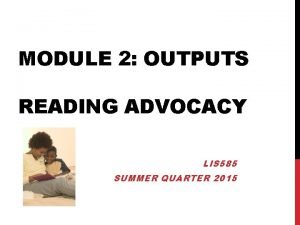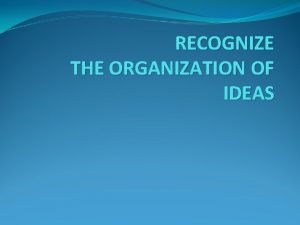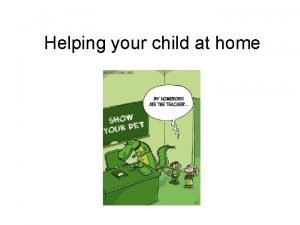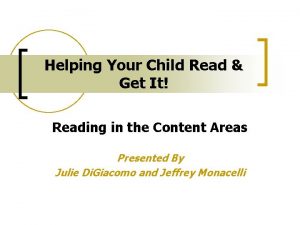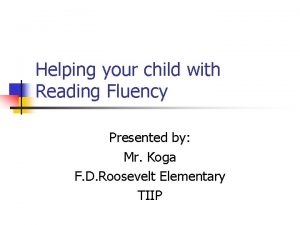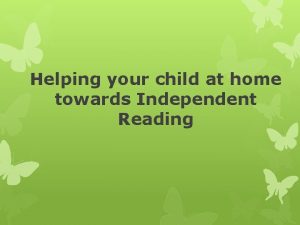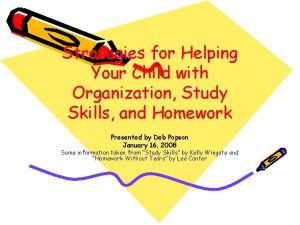Ideas For Helping Your Child Study a Reading











- Slides: 11

Ideas For Helping Your Child Study a Reading Story • The following are some ideas you can use while reading a story with your child. Not everything on the list can or should be used for every story. Choose the ones that go best with the story you are reading. The most important thing is to check their comprehension throughout the story. Let them talk about the story and, if they can, relate it to their life experiences. Most of all enjoy the stories with them. Good readers take pleasure from reading a good story.

Before Reading the Story: • ü Read the story alone before reading it with your child. • ü Check to see what genre (realistic fiction, fantasy, etc. ) the story is. Talk about the characteristics of that genre. Have them name some other stories they have read that are the same genre.

• ü • • • Look at the title, pictures, captions, and/or subtitles and have them predict what they think the story will be about. Ask them why they are making that prediction. Ask questions that help them relate it to events in their lives. ü Go over the vocabulary words. Check to see if they know what they mean. ü Have them think of questions they want answered while reading.

During The Reading • • ü You don’t have to do the whole story in one night. Do a part of it, stop, and ask them to predict what will happen next. Ask them how they came up with their prediction. Is it reasonable? Read the rest of the story the next day. ü Don’t feel you have to correct every mistake they make in oral reading. Correct it if the mistake disrupts or confuses the meaning of the story. Later on you can model the correct pronunciation of the word.

• • • ü Take turns reading with your child. Don’t have them read the whole story out loud to you. You can read one page and have them read the next. You can also have them read a page silently. ü When asking questions, give them time to think about it before responding. How did they figure out the answer? Have them support their answers with events or information from the text, ü Discuss the setting. Where does the story take place? Is there more than one setting? Is the setting important to the story? Why or why not?

• ü Who are the main characters? Describe both physical and personality characteristics of the characters. What is their role in the story? • ü Who are the secondary characters? What role do they play in the story? • ü Which of the characters are they most like? Why? Least like and why?

• ü Identify the vocabulary words in the story. Review the meaning in context. Have them use them in sentences of their own. • ü When you come across an unknown word, reread the sentence it is in and the sentences around it. Have them try to figure out the meaning. If they can’t, help them look it up in a children’s dictionary.

• ü Every few paragraphs stop and ask them questions about what they’ve read or have them retell the important events in their own words. If they can, have them relate the events to things or events in their lives. • ü Have them make predictions. What will happen next? Why do you think that will happen?

• ü Give them questions to think about. What would have happened if…? How would they have done it differently? Why? How do you think the character feels? Why • ü If the story is informational, have them state the important facts every few paragraphs. They can also take notes while reading. •

After Reading the Story • ü Have them tell you the main events of the story in order. • ü Ask if they liked the ending of the story. Why did they like it? Why didn’t they like it? How would they change the ending? • ü Identify the problem and solution of the story. • ü Read about the author and/or illustrator. Have they ever read any other stories by him/her? How are the two stories alike? How are they different? • ü Ask if they liked the story? What did they like about it? What didn't’t they like about it? Would they recommend the story to others? Who? Why or why not?

“ Reading, like playing an instrument, is not something that is mastered once and for all at a certain age. Rather, it is a skill that continues to improve through practice. ” (Taken from “Becoming a Nation of Readers” )
 #awakentheaction
#awakentheaction Pre reading while reading and post reading activities
Pre reading while reading and post reading activities My mother set c
My mother set c 승자트리
승자트리 Ideas have consequences bad ideas have victims
Ideas have consequences bad ideas have victims Que son las ideas complementarias
Que son las ideas complementarias Give us your hungry your tired your poor
Give us your hungry your tired your poor Windrush child
Windrush child Reading homework ideas
Reading homework ideas Reading advocacy ideas
Reading advocacy ideas Skill 2 recognize the organization of ideas
Skill 2 recognize the organization of ideas Fspos vägledning för kontinuitetshantering
Fspos vägledning för kontinuitetshantering
